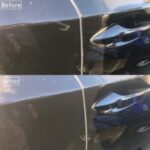Experiencing wind noise after a windshield replacement can be frustrating. It’s natural to wonder if there’s an air leak causing this annoying sound. While a true air leak is less common, wind noise after a windshield repair or replacement is a known issue. Let’s explore the potential causes of this problem and what can be done to address it, focusing on effective windshield air leak repair solutions.
Is It an Air Leak or Just Wind Noise?
First, it’s important to determine if you’re dealing with an actual air leak or just increased wind noise. Wind noise can sometimes be amplified after a windshield replacement due to subtle changes in the sealing or the fit of the new glass. A genuine air leak implies air is physically passing through a gap, which might be accompanied by a whistling sound, especially at higher speeds. If you suspect an air leak, try to pinpoint the location of the noise while driving.
Common Causes of Wind Noise After Windshield Repair
Several factors can contribute to wind noise after a windshield has been replaced:
1. Weatherstrip Issues: Many vehicles utilize a weatherstrip around the windshield to minimize noise, vibrations, and squeaks. This foam or rubber strip can be delicate and might get damaged during the windshield removal process. If the weatherstrip isn’t correctly replaced or is damaged, it can lead to wind noise, particularly from the bottom of the windshield.
2. Urethane Sealant Gaps: The windshield is bonded to the car frame using urethane adhesive. If there are gaps or inconsistencies in this urethane bead, it can create pathways for air to enter, resulting in wind noise and potentially water leaks. This is more likely to cause an actual air leak. Issues at the bottom of the windshield are a frequent culprit for wind noise.
3. Improper Installation: While less frequent, errors during the installation process, such as incorrect glass placement or insufficient sealant application, can also lead to wind noise and air leaks.
Alt text: Close-up of a damaged car windshield weatherstrip, highlighting potential source of air leaks and wind noise after windshield replacement.
Diagnosing the Location of the Leak
The location of the wind noise can offer clues about the potential cause.
- Noise from the bottom of the windshield: This often points to weatherstrip issues or gaps in the urethane sealant at the lower edge.
- Noise from the top or sides: While less common for wind noise alone, noise from these areas might also indicate a potential water leak. If you experience noise from the top or sides, pay close attention for any signs of water entering the vehicle, especially after rain or a car wash.
Alt text: Automotive technician applying urethane sealant around the frame of a car windshield during replacement, critical step to prevent air and water leaks.
Solutions for Windshield Air Leaks
Addressing wind noise and potential air leaks after a windshield repair may involve the following steps:
- Inspection: Carefully inspect the weatherstrip around the windshield for any visible damage or improper seating. Examine the urethane sealant bead for gaps or inconsistencies, especially along the bottom edge.
- Resealing: In some cases, if the problem is localized, a technician might be able to carefully reseal the edge of the windshield to eliminate the noise. This is a less invasive solution than a full replacement.
- Windshield Replacement: If the issue is more extensive or resealing isn’t effective, the windshield might need to be removed and reinstalled. This ensures proper weatherstrip replacement and a complete, consistent urethane seal.
Crucially, always check for water leaks alongside air leaks. Water ingress can lead to significant problems like rust and electrical issues. Water can travel in hidden paths, making it difficult to trace. Thoroughly test for leaks after any windshield repair work.
Alt text: Car repair professional conducting a water leak test on a newly installed car windshield to ensure proper sealing and identify potential air or water leak issues.
Conclusion
Wind noise after a windshield repair can be a sign of an air leak, often due to weatherstrip or sealant issues. Identifying the source of the noise and addressing it promptly is important to prevent further problems like water leaks and rust. While sometimes a simple reseal can solve the issue, in other cases, a complete windshield replacement might be necessary. If you’re experiencing wind noise after a windshield replacement, it’s best to consult with a qualified auto glass technician to diagnose and properly repair the issue, ensuring a quiet and safe driving experience.

